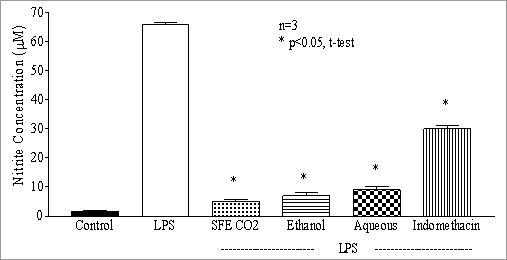Inflammation inhibition of medical plaster extracts through a nitric oxide (NO) blocking pathway Medical plasters have been used for relief of pain and inflammation widely in Taiwan. However, the molecular mechanisms underlying this effect have not been studied. Among mediators of inflammation, nitric oxide (NO) is one of the most important candidates (Chen et al. 2001). In this study, LPS-activated macrophage cells (RAW 264.7) were used to study the anti-inflammatory effects of extracts of medical plasters with respects to NO production, protein synthesis and mRNA synthesis of iNOS gene. Components of medical plaster were extracted by supercritical fluid (SFE-CO2; 0.05mg/ml), ethanol (0.1mg/ml) and H2O (1.5mg/ml). Indomethacin (0.25mM) was used as positive control. RAW 246.7 cells were stimulated in the presence of LPS (1 µg/ml; from E. Coli , serotype 055:B5) with or without the extracts. NO production was measured as nitrite (Griess reagent), iNOS protein and mRNA were also investigated using western blotting and RT-PCR. In the concentration range that was devoid of cytotoxicty, SFE-CO2 (0.05mg/ml), ethanol (0.1mg/ml) and aqueous (1.5mg/ml) extracts of medical plaster, and indomethacin (0.25mM) significantly blocked LPS-induced NO production (p<0.05, figure 1). Protein expression of iNOS was also blocked by the extracts or indomethacin. Interestingly, mRNA expression of iNOS did not show the same pattern of inhibition following incubation with the various extracts of medical plaster. This study shows the extracts of medical plasters effectively block LPS-induced NO production. This effect is through blockage of protein expression of iNOS but not entirely mRNA expression.
Figure 1. Effect of medical plaster extracts on LPS-induced NO production in RAW 264.7 cells. Values were obtained from 3 experiments in triplicate. Asterisks indicate significant difference (p<0.05), compared with that of LPS treated cells. Chen Y-C et al. (2001) Biochemical pharmacology 61: 1417-1427. |


